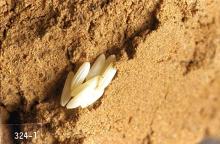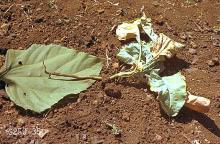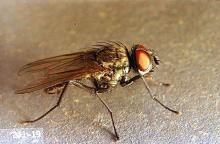Delia brassicae
Pest description, crop damage and life history
See:
Common Pests of Vegetable Crops
Pest monitoring Once the crop emerges, watch for wilting, lighter green plants, or reduced growth that may indicate a maggot infestation. Pull up affected plants, and check roots and soil to confirm the presence of maggots. If several rows of seedling plants are infested, plants may be removed and rows replanted. Drenching with insecticide is also an option, but such treatments are difficult, costly, and may not be adequate.
If roots are tunneled but no maggots are present, maggots have left the roots to pupate, and insecticide treatments would be of little value.
Sticky traps and sweep nets also can be used to monitor the adult fly.
Management-biological control
Rove beetles prey on maggot eggs and young larvae. Rove larvae parasitize the pupa stage of the maggot. The parasitic wasp Trybliographa rapae lays its eggs in the maggot larvae if the larvae are close enough to the soil surface. Biological controls cannot be counted on to provide adequate control.
Management-cultural control
Where maggots are a perennial problem, grow seedlings for transplants in fumigated soil in the greenhouse or under frames of clear plastic. Avoid hardening transplants near infested fields. Direct-seeded crops may avoid some injury when a set of drag chains is attached behind the planter to eliminate the moisture gradient in the seedrow. It is believed that adult flies can locate the seed row for egglaying by honing in on the higher moisture levels created when the soil is overturned for planting.
Older plants may outgrow moderate cabbage maggot populations if maintained with a careful irrigation schedule. Always disc under crop residues immediately after harvest. Maggots can survive for some time in crop residue. Do not follow susceptible crops with susceptible crops, unless sufficient time has passed for the residue to dry or decompose completely.
Management-chemical control: HOME USE
- pyrethrins (often as a mix with other ingredients)-Some formulations are OMRI-listed for organic use.
- zeta-cypermethrin
Management-chemical control: COMMERCIAL USE
- Chenopodium ambrosioides extract (Requiem 25EC) at 4 to 6 pints formulated product per acre, soil application. REI 4 hr. OMRI-listed for organic use.
- cyantraniliprole (Exirel, Verimark) at 0.13 to 0.176 lb ai/A at planting. REI 4 hr. Do not exceed 0.4 lb ai/A per year.
These products contain commonly used active ingredients for control of cabbage maggot in radish. There are other materials available. Please consult a licensed crop advisor for additional recommendations.





